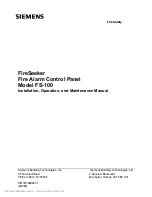
76
8.6.2 Indicating (Signal) Circuits Types
Water-Flow Alarm
An alarm for water-flow sensors. These alarms are identical to normal non-verified
alarms except that any NACs programmed to these circuits (all are by default) are non-
silenceable. Also, if water-flow retard operation is enabled, then these circuits are
sampled every one second; if ten samples are active within any 15 second interval, the
water-flow alarm is confirmed and processed. An alarm condition causes the associated
circuit Status LED and the Common Alarm LED to illuminate red.
Note: Do not use the retard operation with any external retarding device;
maximum retard may not exceed 120 seconds.
Sprinkler Alarm
An alarm for sprinkler flow sensors. These alarms are identical to normal non-verified
alarms unless the water-flow retard operation is enabled. If water-flow retard operation
is enabled, then these circuits are sampled every one second; if ten samples are active
within any 15 second interval, the sprinkler alarm is confirmed and processed. An alarm
condition causes the associated circuit Status LED and the Common Alarm LED to
illuminate red.
Note: Do not use the retard operation with any external retarding device;
maximum retard may not exceed 120 seconds.
General Alarm
These alarms provide remote general alarm such as for remote key switches. In a two
stage system, these inputs perform exactly the same function as the front panel or
remote annunciator General Alarm button. In a single stage system, these inputs act the
same as non-verified alarms, but if correlations are enabled, general alarm initiating
circuits are correlated to
all
NACs.
Non-Latching Supervisory
These alarms are for supervisory devices. An activation on these circuits will cause the
Circuit Status LED and the Common Supervisory LED to illuminate amber. The buzzer
will sound continuously. If the circuit activation is removed, the supervisory condition will
clear (so long as there are no other supervisory conditions in the system) and the circuit
Status LED will extinguish.
Latching Supervisory
These alarms are for supervisory devices. An activation on these circuits will cause the
Circuit Status LED and the Common Supervisory LED to illuminate amber. The buzzer
will sound continuously. If the circuit activation is removed, the Supervisory condition will
not
clear.
Monitor (BLDG)
This is a supervised general purpose non-latching input used mainly for correlating to a
relay circuit. No other system condition occurs as a result of its activation (short-circuit),
although it is supervised for trouble (open-circuit).
Trouble-Only
This circuit is used for monitoring a trouble condition from an external device such as a
Mircom Series 500 Audio System. Both open and short circuits generate a non-latching
trouble condition.
Indicating (Signal) Circuit
Type
Description
Silenceable Signal
For audible devices such as bells and piezo mini-horns that may be silenced either
manually or automatically. While sounding, these follow the pattern appropriate for the
condition: the configured evacuation code (default is temporal code) during single-stage
alarm, or two stage general alarm, or the alert code during a two stage system's alert
(first) stage.
Initiating (Detection) Circuit
Type
Description











































